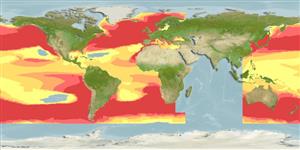The second largest shark, reportedly reaching 1,220-1,520 cm TL (Ref. 247). Thought to live up to 50 years (Ref. 9030, 89083). Semi-oceanic or oceanic species, highly migratory (Ref. 43278). Found on continental and insular shelves, offshore and often close to land, just off the surf zone; enters enclosed bays (Ref. 247). Coastal-pelagic at 1 meter to unknown depths, probably epipelagic (Ref. 58302). Occurs singly, in pairs or groups of 3 or more, or in huge schools (group of up to 100 individuals has been reported) (Ref. 6871, 43278). Prefers water temperature between 8-16 °C (Ref. 88171). Makes extensive horizontal and vertical movements along the continental shelf and shelf edge to utilize productive feeding areas (Ref. 50200). During the summer months, it is found near the surface of boreal to warm-temperate areas (Ref. 43278) feeding on zooplankton by filtering (Ref. 88781). Found in deeper waters during winter (Ref. 6871, 50200, 58302). Undertakes long transoceanic migrations (e.g. from the British Isles to Newfoundland, Canada (Ref. 88824)) and moves between the northern and southern hemisphere in tropical mesopelagic water (Ref. 88825). These migrations have been found to cover distances of over 9,000 km. May form segregations by size or sex (Ref. 88171). Ovoviviparous (Ref. 50449). Regarded as ordinarily harmless and inoffensive but potentially dangerous if attacked (particularly when harpooned) (Ref. 247). In Bay of Fundy, Canada parasitic lampreys have been found attached to the back of basking sharks and sucking their blood (Ref. 83375). Utilized fresh, frozen and dried, or salted (Ref. 9987). Also valued for its liver for oil, fins for soup, hide for leather and carcass for fishmeal (Ref. 247). May be a potential source of anti-carcinoma drugs (Ref. 6034, 6035). Used in Chinese medicine (Ref. 12166). Threatened due to bycatch fisheries (Ref. 83294).
第二个大的鲨鱼, 据报告达到 1,220-1,520 公分TL.(参考文献 247) 栖息于大陆架与岛屿棚了, 外海而且时常接近土地, 正好外海海浪区; 进入封闭的海湾。 (参考文献 247) 慢慢地游泳在水表面,3 或 4 通常成群但是一群向上到 100 已经被报告.(参考文献 6871) 在冬天期间栖息于深水域的底部了。 (参考文献 6871) 滤食桡脚类的动物,藤壶,十足目幼生与鱼卵从水中。 (参考文献 247) 卵胎生的, 胚胎吃产生于母亲的卵黄囊与其他的卵.(参考文献 50449) 被认为了通常无害处而无攻击性但是可能危险如果攻击 (特别地当用鱼叉叉).(参考文献 247) 被冻结而且乾制的生鲜使用, 或盐腌的.(参考文献 9987) 对于它的肝脏用于制造鱼肝油 , 鳍用于汤也评价, 隐藏用做皮革与残骸用于鱼粉.(参考文献 247) 可能是一个抗癌药物的可能来源。 (参考文献 6034,6035) 被用于中药材了。 (参考文献 12166)
Preferred temperature (Ref.
115969): 5.4 - 22.7, mean 11.4 (based on 10877 cells).
Phylogenetic diversity index (Ref.
82804): PD
50 = 1.5000 [Uniqueness, from 0.5 = low to 2.0 = high].
Bayesian length-weight: a=0.00389 (0.00180 - 0.00842), b=3.12 (2.94 - 3.30), in cm Total Length, based on all LWR estimates for this body shape (Ref.
93245).
营养阶层 (Ref.
69278): 3.2 ±0.3 se; based on diet studies.
回复力 (Ref.
120179): 非常低的, 最小族群倍增时间超过14 年 (Fec=1-2; Musick et al. 2000 (Ref.
36717)).
Prior r = 0.07, 95% CL = 0.04 - 0.10, Based on 2 data-limited stock assessments.
Fishing Vulnerability (Ref.
59153): Very high vulnerability (86 of 100).
Climate Vulnerability (Ref.
125649): High vulnerability (62 of 100).
